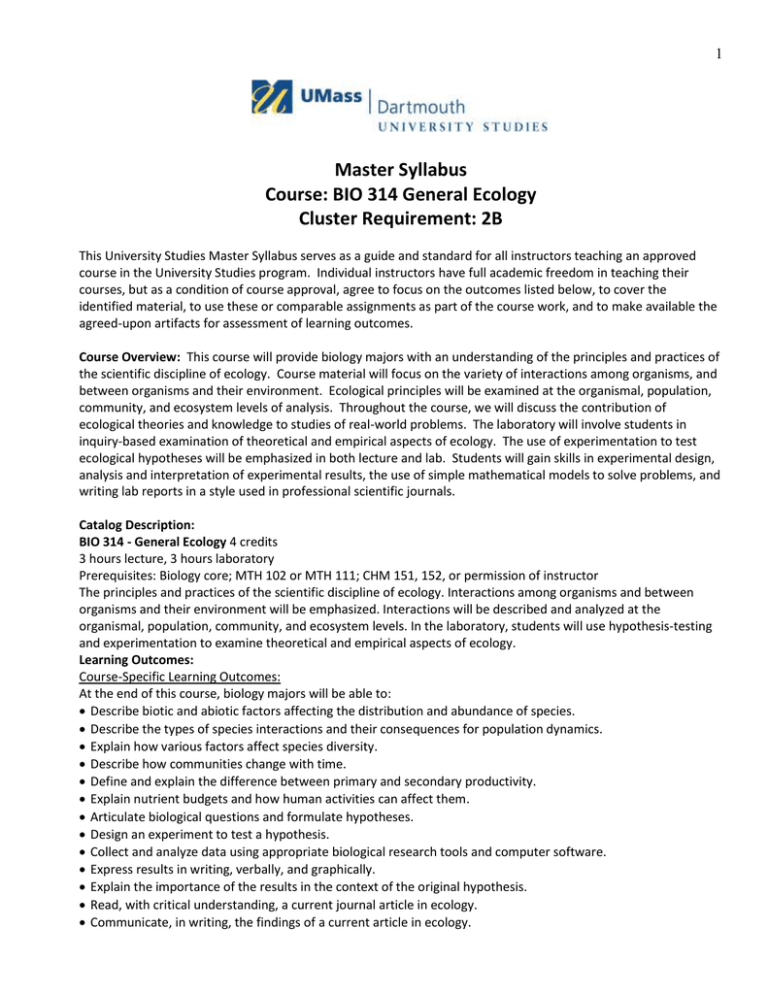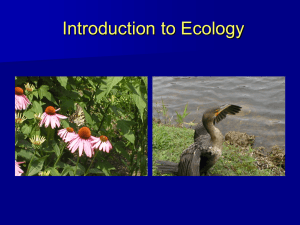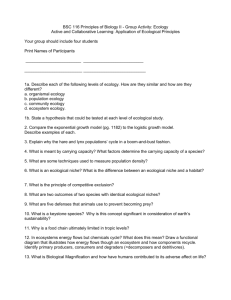
1
Master Syllabus
Course: BIO 314 General Ecology
Cluster Requirement: 2B
This University Studies Master Syllabus serves as a guide and standard for all instructors teaching an approved
course in the University Studies program. Individual instructors have full academic freedom in teaching their
courses, but as a condition of course approval, agree to focus on the outcomes listed below, to cover the
identified material, to use these or comparable assignments as part of the course work, and to make available the
agreed-upon artifacts for assessment of learning outcomes.
Course Overview: This course will provide biology majors with an understanding of the principles and practices of
the scientific discipline of ecology. Course material will focus on the variety of interactions among organisms, and
between organisms and their environment. Ecological principles will be examined at the organismal, population,
community, and ecosystem levels of analysis. Throughout the course, we will discuss the contribution of
ecological theories and knowledge to studies of real-world problems. The laboratory will involve students in
inquiry-based examination of theoretical and empirical aspects of ecology. The use of experimentation to test
ecological hypotheses will be emphasized in both lecture and lab. Students will gain skills in experimental design,
analysis and interpretation of experimental results, the use of simple mathematical models to solve problems, and
writing lab reports in a style used in professional scientific journals.
Catalog Description:
BIO 314 - General Ecology 4 credits
3 hours lecture, 3 hours laboratory
Prerequisites: Biology core; MTH 102 or MTH 111; CHM 151, 152, or permission of instructor
The principles and practices of the scientific discipline of ecology. Interactions among organisms and between
organisms and their environment will be emphasized. Interactions will be described and analyzed at the
organismal, population, community, and ecosystem levels. In the laboratory, students will use hypothesis-testing
and experimentation to examine theoretical and empirical aspects of ecology.
Learning Outcomes:
Course-Specific Learning Outcomes:
At the end of this course, biology majors will be able to:
Describe biotic and abiotic factors affecting the distribution and abundance of species.
Describe the types of species interactions and their consequences for population dynamics.
Explain how various factors affect species diversity.
Describe how communities change with time.
Define and explain the difference between primary and secondary productivity.
Explain nutrient budgets and how human activities can affect them.
Articulate biological questions and formulate hypotheses.
Design an experiment to test a hypothesis.
Collect and analyze data using appropriate biological research tools and computer software.
Express results in writing, verbally, and graphically.
Explain the importance of the results in the context of the original hypothesis.
Read, with critical understanding, a current journal article in ecology.
Communicate, in writing, the findings of a current article in ecology.
2
University Studies 2B Learning Outcomes: Science in the Engaged Community
After completing this course, students will be able to:
1. Analyze and evaluate the use of scientific information in the context of social, economic, environmental or
political issues.
2. Apply scientific theories and knowledge to real-world problems.
3. Effectively communicate scientific information in writing.
Examples of Texts and/or Assigned Readings:
Required: Krebs, Charles J. 2009. Ecology: The Experimental Analysis of Distribution and Abundance (6th ed.)
Benjamin Cummings
Recommended: Pechenik, Jan A. A Short Guide to Writing About Biology Pearson/Longman (any recent edition is
fine)
Example Learning Activities and Assignments:
Consideration of the environmental policy implications of the study of ecology will be embedded in lectures, as
indicated in the sample course outline below. At the end of the course, students will be asked to write a final
reflection with the following instructions: “Choose an ecological topic we have discussed in class that has
relevance for present-day environmental problems (e.g., bioinvasions; climate change; habitat alteration,
fragmentation, or loss; eutrophication.) What kinds of ecological studies could provide information relevant for
policy decisions? Describe the scientific information you would share with legislators responsible for crafting
environmental policy on this topic.” In their reflection, students will need to show that they 1) understand the
scientific basis of the environmental problem, 2) understand the type of ecological data needed to address it, and
3) can communicate the ecological information in a context understandable by policy makers. This reflection
addresses all three US 2B learning outcomes.
Sample Course Outline:
Week
General Topic
1
Introduction to Ecology
Analyzing Geographic Distributions
2
Biotic Factors that Limit Distributions
3
Abiotic Factors that Limit Distributions
4
Factors that Limit Distributions (cont'd)
5
Population Parameters
6
Population Growth
7
Competition
8
Predation
9
Biodiversity
10
Succession
11
12
13
14
Equilibrial Communities
Nonequilibrium Communities
Primary Production
Secondary Production
Nutrient Cycles
Ecosystem Services
Environmental Issues and Real-World Problems
How can ecology contribute to environmental policy?
Species introductions (biological invasions)
Climate change
Natural and human-caused disturbances
Habitat fragmentation and loss
Eutrophication
Nutrient inputs and exports, hydrological cycle
Benefits to society from ecosystem functions





